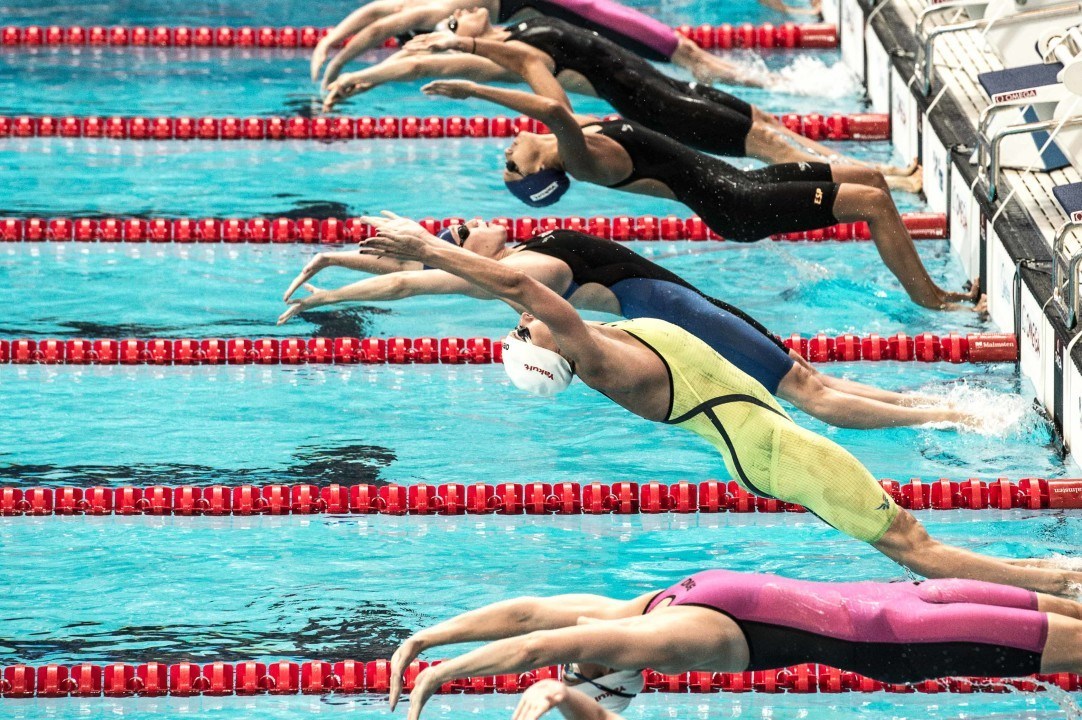The National Federation Of State High School Association (NFHS) has announced their points of emphasis for the 2015-2016 season in swimming and diving. The NFHS Foundation serves those who participate in high schools sports and they also serve to minimize risks in all interscholastic sports. Their purpose for the sports are to make sure each sport is sufficiently funded, promote the athletics program in each school, provide information to all coaches and high school administrators, and give grants to organizations that qualify.
Each year, the NFHS announces certain points of emphasis for its officials. This year, the following points have been announced to remind all swim and dive teams competing this year to make sure the rules are followed correctly, to keep the swimmer’s safe from injury, and the team’s from being disqualified.
These rules are as followed:
- Uniform responsibilities – making sure you have it right – The ultimate responsibility of ensuring that all athletes are attired in legal and appropriate suits and caps rests with the coach. It may be that the school is purchasing the suits/caps or it could be the individual student has the purchasing responsibility. Regardless, the coach maintains the responsibility for educating the students of what is legal and appropriate. Construction and design is of concern as well as the size and number of the manufacturer’s logo, size of any post-construction logo, size of American flag and size and permission for any commemorative patch. For example, suits not manufactured in the United States will many times exceed the allowable size of a manufacturer’s logo. Jewelry is no longer prohibited. Religious and medical-alert medals are still legal. The medical alert should be worn so the alert is visible to assist a health-care professional. Coaches and athletes have the responsibility to refrain from wearing jewelry that takes away from the integrity of the sport or poses a high likelihood of coming loose during competition. A review of what is legal and required by rule should be conducted each season by the coach and with his/her athletes each year before the competitive season begins.
- Focus on risk minimization in development of warm-up procedures – It is very important that each school has an established warm-up procedure that focuses on risk minimization. Likewise, state associations may want to consider establishing a warm-up procedure similar to the suggested procedures located in the front of the NFHS Swimming and Diving Rules Book. Before any contestants enter the water to begin warm-ups, there should be a meeting including head coaches and captains from each participating team. The information to be reviewed should include, but is not limited to, the warm-up procedures for the venue. Coaches should insist that his/her athletes always follow the rules for warm-ups to provide an environment free of unnecessary injuries.
- Coaching starts and turns can prevent injuries – Coaching the proper techniques for starts and turns plays an important role in preventing the swimmers from incurring an unnecessary injury in addition to assisting in their success in these two components of the race. Coaches should take the time to properly instruct and review with all swimmers. It is important for the coach to observe the individual swimmers to be certain he/she masters the start and the turns for their respective events.
- Ensuring the 16.4 yards (15-meter) mark is clearly visible – The 16.4 yards (15-meter) mark must be clearly visible. It is preferred to be marked on the deck on each side of the pool with a painted mark, bright tape or a bright cone, although it is easy to move a cone unintentionally. The 16.4 yards (15 meters) should also be marked on the lane markers. The mark on the pool deck is the most definitive and should the lane markers not be consistent with the mark on the deck, the deck marking takes priority.
- Preparing the lap counter – Each school has the duty to adequately train individuals to serve as lap counters for their school. The host school is required to provide a visual lap counting system for the visiting teams as well as for their own school. Individuals serving as lap counters shall not enter the water, must remain on deck within the boundaries of their respective lanes and know when to change the visual count. This takes place by changing to the next higher odd number as the competitor makes each turn at the starting end. Once changed, as the swimmer approaches the end wall for the turn, the visual lap counting system is lowered into the water and removed before the swimmer initiates the turn. The solid orange card is shown to indicate the final length of the race. The individual serving as a lap counter may also give a verbal count and is not there to cheer on his/her teammate.
Some of these points of emphasis are new rules, whereas others are just highlighting existing rules that the NFHS feels need special attention. Among the more significant rules changes for this season are the officials uniforms, the ability to change of responsibility ringing of the bell during the last lap of the 500 yard free/400 meter free,the official diving referee position as a judge, and the jewelry rule.
The rule regarding the officials uniform has changed form being that all officials must wear all white or the approved uniform by the state association has been changed to that all officials are to wear the same uniform administrated by the state association. Another rule regarding the ringing of bell has been changed to allows the starter to designate another person to ring the bell for the swimmer in the lead at the 500 yard free/400 meter free to let the swimmer know their are starting their final lap and the final rule of the official diving referee now allows the referee to be one of the judges on the scoring panel or a separate official. The rule regarding jewelry has been changed, lifting the ban from jewelry. before, jewelry was prohibited because caused risks to the swimmers, but rule has been changed due the fact that that it was an unnecessary restriction.


Can someone please explain the significance of only being allowed to have one logo on your bathing suit? If it is FINA approved shouldn’t it be allowed?
I believe this rule was developed to prevent schools that are more affluent to have sponsorships being displayed on their swimming uniform. While the use of more than one logo may be just a perceived disparity in economic affluence of one team versus another, in some cases it actually does contribute to increased economic diversity where recruiting is heavy. We know recruiting exists, even if the coaches and boosters deny it. There is no good way of monitoring and disciplining recruiting violations at the high school level.
And banning two logos is the way to combat recruiting?
No, it is not. But it does make it less obvious that one school is more affluent in terms of private endowments or public sponsorship. When some schools are barely fielding a full roster, struggling to get money allotted from their athletic department or are from a lower economic area, there is a correlation between what you have (shirts, jackets, suits, etc) and performance. Now swimming is an individual sport, but if you are looking for a school for your child to attend and swim at, you look at the whole and those schools that can display that they have support will likely draw student-athletes much easier than those schools that cannot.
If you are saying that more than one logo on a suit is an obvious sign of affluence, then what about matching sweat suits, parkas, towels, backpacks, etc.?
There must be another reason for this rule. It isn’t necessarily a *good* reason, but trying to avoid overt displays of affluence can’t be it.
Becky D – it’s probably a general attempt to fight commercialization of high school athletics. Other sports have similar rules. Specifically to swimming, manufacturers logos are made of non-permeable materials in many cases, and there’s some obvious implications as to buoyancy and the like from that.
So if a kid enthusiastically yells how many laps to go, is that considered cheering and the swimmer is then DQed? ELEVEN!!!!!!!!! THIRTEEN THIS IS NOT CHEERING!!!!
“The individual serving as a lap counter … is not there to cheer on his/her teammate.”
Killjoys!